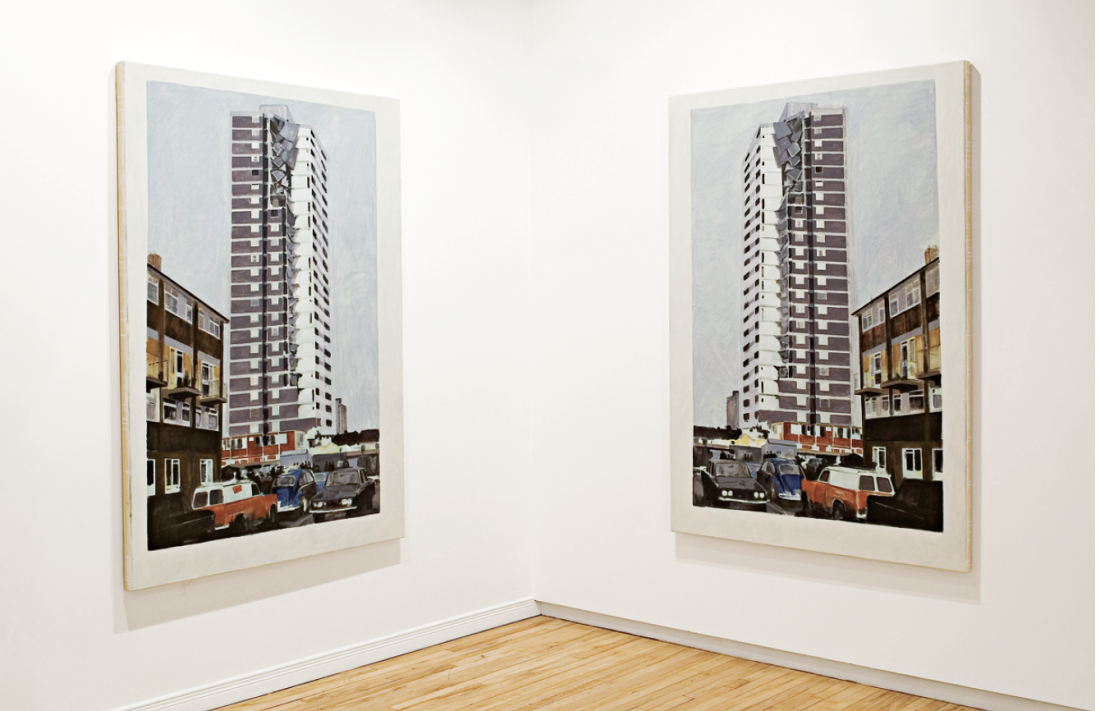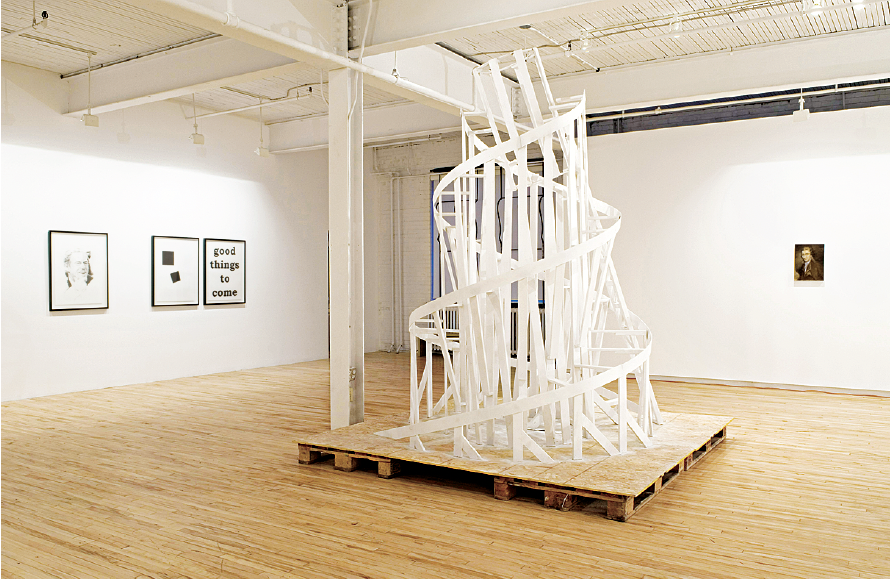Grier Edmundson
Vladimir Nabokov, in his noted essay “Good Readers and Good Writers,” states, “A good reader, a major reader, an active and creative reader is a rereader.” “The Work Ahead of Us,” an exhibition by Memphis-born artist Grier Edmundson is, in essence, an exercise in rereading. Privileged or burdened by the knowledge of the conclusion, we step back from the narratives and perceive them cast in another light, and we may sense that we are on the leading or penultimate edge of something significant. Standing before Edmundson’s paintings, we find ourselves standing before premonition or that terrible silence of aftermath—both points leave us wishing that what comes before or after could be or have been different. We know, however, that there is nothing left but resignation, so we look again, and maybe now that gaze is a wide-eyed stare, and the rereading begins again.
In another treatise on narratology and reading Narrative and Freedom: The Shadows of Time, Gary Saul Morson talks of a technique he defines as “sideshadowing.” According to Morson, “sideshadowing admits, in addition to actualities and impossibilities, a middle realm of real possibilities that could have happened even if they did not.” I think this term “sideshadowing” is very applicable to the work presented to us in Edmundson’s show, which in itself is a tribute to social progress, idealism and possibility, tempered by limitation—what could have been—and the hope of things to come.

Grier Edmundson, quietly come, quietly go (Ronan Point 24 times), 2009, oil on canvas, 2 panels, 60” x 42” each. Photo by: Éliane Excoffier. Courtesy of the artist and Battat Contemporary, Montreal.
“The Work Ahead of Us” is at once an eclectic yet cohesive collection of recent works. Oscillating between pessimism and optimism, Edmundson joins disparate points in history portrayed through various media and styles. His comfort in each medium and his differing perspectives attest to his versatility as both an artist and a thinker. What he presents is not a linear revisitation of history but rather a memory palace of sorts, moments suspended not necessarily in order but with great contemplation and conviction. For example, in ode to Common Sense (after Millière), 2009, the portrait of American revolutionary Thomas Paine is rendered in such a way, in the use of light and colour, that it is of another century (Auguste Millière painted his version in 1880). Also notable is that Millière painted this portrait after an engraving by William Sharp, 1793, which was after a painting by George Romney, 1792. Through his interpretation of this painting in the year 2009, Edmundson has added himself to history. The other portrait in the show, a drawing of the first president of the Czech Republic, Václav Havel, has in it, in its cleanliness of line, a suggestion of vibrancy, of luminance such that one feels a projection of his character. Here are two different revolutionary figures, both successfully portrayed with respective time and place taken into consideration. The choice of these personalities is interesting in that they are figures that rest in the shadows of iconic revolutionaries like Che Guevara or Martin Luther King Jr.
Like Gerhard Richter or Luc Tuymans, Edmundson at times chooses images extracted from media sources. These are images that exist somewhere within us; we feel we know them, even if we cannot name them, like shadowy carbon copies imprinted on the mind after repeated exposure. However, I would say that in the rendering of the subject matter, Edmundson is consistently more forthright with information than the aforementioned artists. Although the original source of many of the images is the photograph, in the interpretation, the images do not feel like “snapshots” that have a suggestion of brevity even in the nomenclature. Rather, Edmundson’s paintings possess a depth and weight that suggest permanence and history. Along with the significance of the moment captured (or the one which evaded capture), the act of his portraying it is also significant.
The images Edmundson often chooses are of the faded icon—now nebulous heroes abandoned by a fickle collective memory. How is it that progress can be measured, then, if the past cannot be wholly remembered? In a media-driven society, our relationship with history seems increasingly superficial, the more recent past coming to replace the distant past, where speed has usurped accuracy. A second look, a revisitation, is necessary to verify the great number of subjectively slanted narratives given us on a daily basis.

Exhibition view of “Grier Edmundson: The Work Ahead of Us,” 2009, Battat Contemporary, Montreal. Photo by: Éliane Excoffier. Courtesy of the artist and Battat Contemporary.
One of the narratives Edmundson presents is the partial collapse in 1968 of Ronan Point, an East London social housing project. In quietly come, quietly go (Ronan Point 24 times), 2009, the artist has painted two mirror images of the destroyed building. The two canvases are hung at a corner point where two walls meet so that they give the suggestion of reflection—it is history held up to itself. Through immediate response, we experience two points in history even if only one is depicted. When we see the imploded building, part of which has fallen like a house of cards (which is in fact how it was described in the subsequent investigation of the collapse), we can’t help but think of the World Trade Towers. These are narratives that extend past the confines of the canvas and the phenomenon of time. You look at the crumbled building and you imagine (how can you not?) the events that preceeded this moment. If you learn the actual story, that Ronan Point was a project flawed in design and in construction, you begin to see this was a house of cards before it was ever built; but it was built and did what it could only do: it fell. Looking at these paintings, you realize a short story has been written, and the artist, a major reader (and writer) himself, has handed you the jumping off point.
Although all the works in the show are worthy of mention, the one that is likely most representative of Edmundson’s play on progress is We will see what is possible, 2009, a reconstruction of Vladimir Tatlin’s Monument to the Third International, 1919, and the sole sculptural piece of the show. There is something playful about the work, but it is also fodder for serious consideration as to whether we are in the possession of, or are capable of mustering, sufficient optimism to dream an idea as grandiose as this. As impractical and romantic as the proposal may have been, one cannot help but be impressed by the magnitude of planning and the degree of optimism involved. As John Milner succinctly comments about Tatlin’s Tower, “It indicated an imaginative grasp at possibilities which, in physical terms, remained just out of reach. But if it was utopian, it was proposed at a time when Utopia was apparently receiving material and social foundations.” The closing sentence suggests we question what is on the receiving end of material and social foundations in our current times. The answer would seem to be something quite far from utopian ideals. ❚
“The Work Ahead of Us” was exhibited at Battat Contemporary in Montreal from November 5 to December 19, 2009. The exhibition was accompanied by a publication entitled America’s Prodigy. Text: Luke Collins, Translation: Ingrid Thompson, Graphic Design: Grier Edmundson. The following bilingual website is affiliated with the publication: www.oscarbox.org/GE/x/.
Tracy Valcourt is a writer who lives in Montreal.

